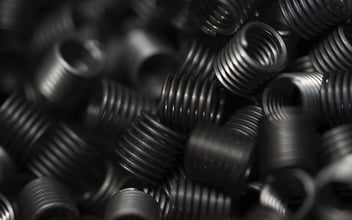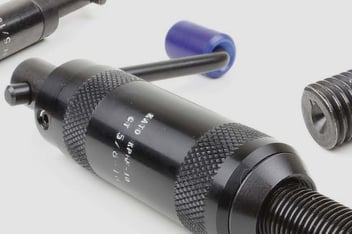Choosing the right fastening method for a mechanical joint can be the difference between a component that lasts decades and one that fails before it ever leaves the factory floor. Every fastening solution brings its own strengths and weaknesses which make it important to match the right joint to your parent materials and operating environment.
Engineers need a clear understanding of the common fastening options for mechanical joints, their pros and cons and why wire thread inserts can turn traditional screw and bolt joints into one of the most versatile and durable solutions available today.
The types of fastening options in detail
Mechanical joints can be secured using a variety of fastening methods each with distinct performance characteristics and suitability for different materials and operating environments.
Clinching
Clinching is a mechanical fastening process where two or more sheets of metal are plastically deformed in a punch-and-die setup to interlock without the need for additional fasteners or heat. The technique offers high manufacturing efficiency and low cost, making it a viable choice for large-scale production in controlled environments.
Strengths:
- High manufacturing speed and low cost per joint.
- Suitable for thin-gauge and soft metals.
- No need for additional fasteners or adhesives.
Limitations:
- Low shear strength; unsuitable for high-load applications.
- Limited resistance to corrosion, wear, and temperature fluctuations.
- Best for non-critical assemblies in mild operating environments.
Rivets
Riveting involves driving a metal pin through a pre-drilled hole then deforming the tail to lock it in place. Riveted joints are known for their strength and reliability in applications that require long-term structural integrity, such as aerospace fuselage skins and large-scale infrastructure.
Strengths:
- High shear strength for structural applications.
- Excellent fatigue resistance under cyclic loading.
- No heat required during assembly, protecting parent material integrity.
Limitations:
- Difficult to remove or replace without damage to surrounding components.
- Susceptible to galvanic corrosion when joining dissimilar metals.
- Requires precise drilling and alignment to avoid weakening the structure.
Screw and bolt joints
Screw and bolt joints are among the most versatile fastening methods, using threaded fasteners installed into tapped holes or paired with nuts. They can be installed and removed multiple times, making them ideal for assemblies requiring regular maintenance.
Strengths:
- High shear and tensile capacity.
- Easy installation, inspection, and replacement.
- Broad size and material availability for different applications.
Limitations:
- Stress concentrations can cause thread stripping in softer materials.
- Prone to fretting wear and preload loss under cyclic loading.
- Performance can degrade quickly in lightweight alloys without reinforcement.
Where wire thread inserts fit into the conversation
Wire thread inserts are helical coils that are installed into tapped holes to create a hardened, wear-resistant internal thread for bolts and screws. By distributing load evenly across the full thread engagement length, they protect parent materials from the concentrated stresses that lead to wear, deformation and thread failure. This makes them a perfect partner when it comes to bolt and screw joints, almost eliminating all of their limitations to enhance performance and component life.
Key advantages when paired with bolt and screw joints
- Enhanced strength: Even load distribution prevents thread stripping and increases joint reliability in high-load applications.
- Lightweight material compatibility: Enables the safe use of aluminium, magnesium, and other soft alloys in demanding environments.
- Corrosion resistance: Acts as a barrier to galvanic and environmental corrosion; can be manufactured in alloys such as phosphor bronze or Inconel for extreme environments.
- Thermal resistance: Maintains integrity under significant temperature fluctuations.
- Maintenance efficiency: Tangless designs eliminate foreign object debris and allow rapid removal and replacement.
So which option is the best fit for your application?
Choosing the most suitable fastening method requires balancing strength, environmental resistance, ease of maintenance, and compatibility with the parent material. No single solution is universally ideal, but each offers specific advantages when applied in the right context. The following summary outlines the typical best-fit applications for each method:
Clinching: High-volume, low-cost assemblies in mild environments with minimal load requirements.
Rivets: Permanent joints in high-load, high-fatigue applications where disassembly is unlikely.
Screws and bolts: Versatile fastening for applications requiring regular access or adjustment, provided parent materials are sufficiently strong.
Screws/bolts with wire thread inserts: High-strength, corrosion-resistant fastening for lightweight or soft materials with extended service life and simplified maintenance.
Maximising mechanical joint performance for your application
Selecting the right fastening method is critical to achieving durability and efficiency in mechanical joints. Each option serves a specific purpose, but only when matched to the right material, load and environment.
KATO® Advanex wire thread inserts strengthen conventional joints, protect lightweight materials and deliver exceptional resistance to wear and corrosion. With Tanged and Tangless designs in multiple materials and finishes, they meet the highest aerospace, military and commercial standards. They directly make bolt and screw joints a perfect fit for most applications.
To explore our full range of wire thread inserts and find the right solution for your application, download our guide below.









.jpg?width=352&name=Shutterstock_1357488977%20(1).jpg)
.jpg?width=352&name=Shutterstock_2288877403%20(1).jpg)

